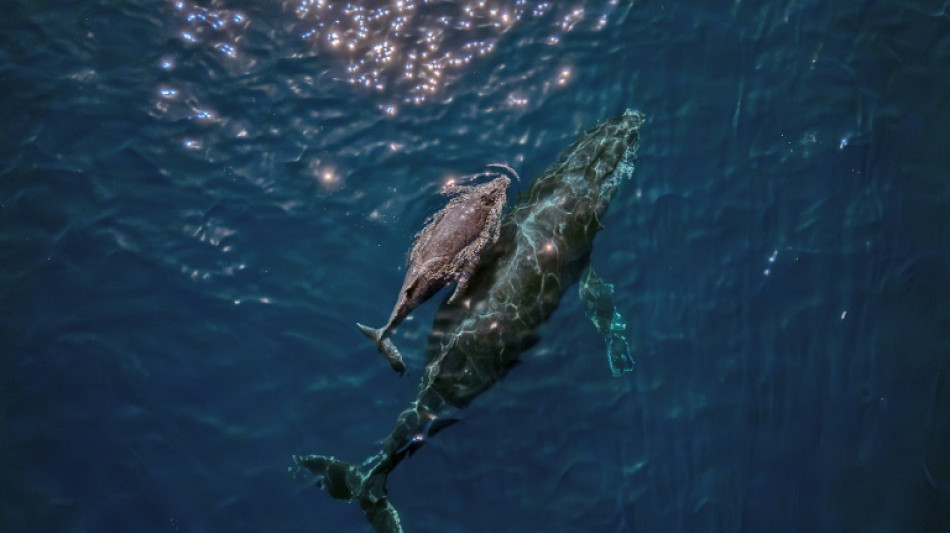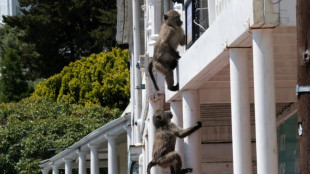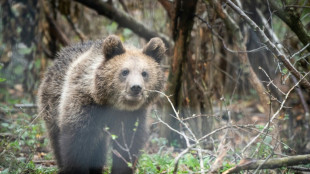
-
 Dortmund boss calls for member vote on club's arms sponsorship deal
Dortmund boss calls for member vote on club's arms sponsorship deal
-
Chanel family matriarch dies aged 99: company

-
 US boss Hayes says Chelsea stress made her 'unwell'
US boss Hayes says Chelsea stress made her 'unwell'
-
China's Ding beats 'nervous' Gukesh in world chess opener

-
 Man City can still do 'very good things' despite slump, says Guardiola
Man City can still do 'very good things' despite slump, says Guardiola
-
'After Mazan': France unveils new measures to combat violence against women

-
 Scholz named party's top candidate for German elections
Scholz named party's top candidate for German elections
-
Flick says Barca must eliminate mistakes after stumble

-
 British business group hits out at Labour's tax hikes
British business group hits out at Labour's tax hikes
-
German Social Democrats name Scholz as top candidate for snap polls

-
 Fresh strikes, clashes in Lebanon after ceasefire calls
Fresh strikes, clashes in Lebanon after ceasefire calls
-
Russia and Ukraine trade aerial attacks amid escalation fears

-
 Georgia parliament convenes amid legitimacy crisis
Georgia parliament convenes amid legitimacy crisis
-
Plastic pollution talks must not fail: UN environment chief

-
 Beeches thrive in France's Verdun in flight from climate change
Beeches thrive in France's Verdun in flight from climate change
-
UAE names Uzbek suspects in Israeli rabbi's murder

-
 Indian author Ghosh wins top Dutch prize
Indian author Ghosh wins top Dutch prize
-
Real Madrid star Vinicius out of Liverpool clash with hamstring injury

-
 For Ceyda: A Turkish mum's fight for justice for murdered daughter
For Ceyda: A Turkish mum's fight for justice for murdered daughter
-
Bestselling 'Woman of Substance' author Barbara Taylor Bradford dies aged 91

-
 Ukraine drones hit Russian oil energy facility: Kyiv source
Ukraine drones hit Russian oil energy facility: Kyiv source
-
Maximum term demanded in French rape trial for husband who drugged wife

-
 Salah feels 'more out than in' with no new Liverpool deal on table
Salah feels 'more out than in' with no new Liverpool deal on table
-
Pro-Russia candidate leads Romanian polls, PM out of the race

-
 Taiwan fighter jets to escort winning baseball team home
Taiwan fighter jets to escort winning baseball team home
-
DHL cargo plane crashes in Lithuania, killing one

-
 Le Pen meets PM as French government wobbles
Le Pen meets PM as French government wobbles
-
From serious car crash to IPL record for 'remarkable' Pant

-
 Philippine VP Duterte 'mastermind' of assassination plot: justice department
Philippine VP Duterte 'mastermind' of assassination plot: justice department
-
India two wickets away from winning first Australia Test

-
 39 foreigners flee Myanmar scam centre: Thai police
39 foreigners flee Myanmar scam centre: Thai police
-
As baboons become bolder, Cape Town battles for solutions

-
 Uruguay's Orsi: from the classroom to the presidency
Uruguay's Orsi: from the classroom to the presidency
-
UN chief slams landmine threat days after US decision to supply Ukraine

-
 Sporting hope for life after Amorim in Arsenal Champions League clash
Sporting hope for life after Amorim in Arsenal Champions League clash
-
Head defiant as India sense victory in first Australia Test

-
 Scholz's party to name him as top candidate for snap polls
Scholz's party to name him as top candidate for snap polls
-
Donkeys offer Gazans lifeline amid war shortages

-
 Court moves to sentencing in French mass rape trial
Court moves to sentencing in French mass rape trial
-
'Existential challenge': plastic pollution treaty talks begin

-
 Cavs get 17th win as Celtics edge T-Wolves and Heat burn in OT
Cavs get 17th win as Celtics edge T-Wolves and Heat burn in OT
-
Asian markets begin week on front foot, bitcoin rally stutters

-
 IOC chief hopeful Sebastian Coe: 'We run risk of losing women's sport'
IOC chief hopeful Sebastian Coe: 'We run risk of losing women's sport'
-
K-pop fans take aim at CD, merchandise waste

-
 Notre Dame inspired Americans' love and help after fire
Notre Dame inspired Americans' love and help after fire
-
Court hearing as parent-killing Menendez brothers bid for freedom

-
 Closing arguments coming in US-Google antitrust trial on ad tech
Closing arguments coming in US-Google antitrust trial on ad tech
-
Galaxy hit Minnesota for six, Orlando end Atlanta run

-
 Left-wing candidate Orsi wins Uruguay presidential election
Left-wing candidate Orsi wins Uruguay presidential election
-
High stakes as Bayern host PSG amid European wobbles


Back from the brink: the migratory species on the road to recovery
While a landmark new report on the world's threatened migratory species is a catalogue of decline and destruction, the handful of animals staging a comeback shows improvement is possible -- if humans change their ways.
From the majestic humpback whale launching into the air from the waves, or the thousands of snub-nosed saiga antelope fanning across the steppes of Central Asia. These sights would have been barely possible without the concerted conservation efforts that have helped these species rebuild populations.
The State of the World's Migratory Species assessment, published Monday, found that animals, fish, birds and reptiles listed for protection under the UN Convention on the Conservation of Migratory Species of Wild Animals (CMS) were seeing declines across the world.
Around 70 of the threatened species saw their conservation status worsen between 1988 and 2020.
But 14 have shown an improvement, it found. Here are some of those recovering species:
- Humpback whales -
For hundreds of years, whalers from across the planet hunted humpback whales for their oil, meat, and baleen -- their feeding filtration system.
According to the International Union for Conservation of Nature (IUCN) they were targeted by early hunters in their wintering areas near the West Indies and Cape Verde, then near their summer feeding grounds from the 1860s, especially off Iceland and Norway. In the Pacific they were hunted particularly by Japanese whalers.
By 1986, the IUCN had listed the species as globally endangered.
International restrictions on commercial whaling allowed the humpback whale population to rebound and today, more than 80,000 mature individuals navigate throughout the world's oceans.
While some subpopulations have now recovered more than 90 percent of their pre-whaling numbers, the CMS report said other smaller groupings like the humpbacks in the Arabian Sea, were still endangered.
Continuing threats include from fishing gear, underwater noise pollution, and collisions with ships.
- Vicuna -
Vicunas, a llama-like creature that roams wild in parts of Argentina, Bolivia, Ecuador, Chile, Peru, is one of the few undomesticated animals sought for its wool.
Illegal poaching brought vicunas to the brink of extinction.
Numbers are now increasing thanks to legal protection from hunting, an international trade ban and education initiatives and the vicuna conservation status has changed from near threatened to least concern.
But threats from poaching for the illegal market, habitat encroachment and climate change remain.
- Lesser Kestrel -
The lessekestrel was once one of the most abundant small, migratory birds of prey that could befound from Spain to southern Russia to China.
The use of pesticides, especially DDT from the 1940s to 1970s, poisoned the birds directly and caused a drastic reduction in prey.
Habitat loss from urbanisation and agricultural intensification also caused severe population declines throughout Europe.
Since the 1980s, targeted conservation efforts -- like providing artificial nests, restoring breeding colonies, and releasing captive-bred birds into the wild -- have helped boost populations in southwestern Europe.
- Saiga Antelope -
National and international conservation efforts helped bring the Saiga Antelope back from the brink of extinction.
The revival of Kazakhstan's steppe and wetland habitats, projects to reintroduce native species and efforts to work with local communities to address overexploitation all played a role in their recovery.
Its population in Kazakhstan rebounded from a perilous low of 50,000 individuals in 2006, to over 1.3 million in 2022.
The species has now partially resumed migration into Uzbekistan.
- Black-Faced Spoonbill -
The black-faced spoonbill is a migratory seabird found in North and South Korea, China, Russia, Japan, Vietnam, Cambodia, Thailand, and the Philippines.
These white wading birds travel along a restricted migration route for breeding and wintering.
Their habitat has come under threat from growing human populations and agricultural and industrial development, while the birds face pesticide pollution, hunting, and the collection of eggs from nesting sites.
But legal protections, the designation of breeding sites as seabird sanctuaries and wetland restoration projects have all helped to improve the species' status from critically endangered to endangered.
J.Pereira--PC




